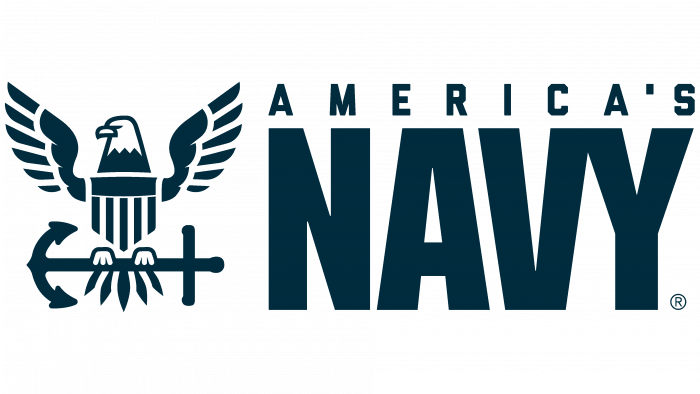The Navy logo looks like a structure woven from sea ropes, fixed on the ship’s steering wheel. The emblem is an ode to courage, resilience, and endurance, which allow you to protect the most precious thing – the freedom and security of your native country.
Navy: Brand overview
| Founded: | 13 October 1775 |
| Founder: | United States Armed Forces |
| Headquarters: | Arlington County, Virginia, U.S. |
| Website: | navy.mil |
Meaning and History
The origins of the USN date back to 1775, when delegates from 13 British colonies decided to acquire two ships to raid British merchant ships. This is how the Continental Navy appeared, which was disbanded in 1785. After that, the United States did not have a navy for a long time, apart from the Coast Guard. This state of affairs led to impunity for pirates, so the government was forced to issue a decree on constructing new frigates. They played a decisive role in further battles and took part in the fight against the slave trade.
In the 1880s, the modernization of USN ships began. The improved fleet came in handy during the two world wars, after which the US authorities decided to strengthen the weapons at the expense of aircraft carrier battle groups. Technological progress is still not slowing down: even now, in the 21st century, the country continues to develop a flotilla to ensure world order.
What is the Navy?
The Navy is a branch of the United States Armed Forces, officially known as the United States Navy. The USN includes a powerful naval fleet, helicopters, and planes capable of performing various tasks, from protecting territorial waters to participating in humanitarian missions. Submarines and ships are deployed in different regions to ensure global security and maintain control.
Currently, the US Navy owns many bases on different continents. At the same time, the unit itself is under the jurisdiction of another organization – the United States Department of the Navy. The historical legacy of DoN is reflected in the seal and flag, which were approved by presidential decree in the late 1950s. About 20 years later, designers developed the modern USN logo based on them. It was created for informational purposes and has not changed since the early 1970s.
The United States Navy logo is a round color print and represents the long history of the American people’s struggle for independence. The symbolism is the same as for other types of troops. First of all, they are united by the image of the bald eagle, which has been considered the national bird of the United States since the 1700s. It can also be seen on coins and military flags. The eagle is associated with authority, power, power, and strength.
The second common element is the anchor. On the USN emblem, it is slightly wrapped in rope and is in the paws (that is, under the protection) of a bald eagle. A bird of prey holds it in the air, spreading its wings wide. This anchor is featured on almost all military flags and seals. It stands for navigation, ordeal, and team unity.
A shield with a blue top is depicted on the eagle’s chest. A similar motif is found on the official state emblem – Great Seal of the United States. The main part of the shield is divided into thirteen stripes in red and white. They are the same as on the American flag; only they are located not horizontally but vertically. Each line represents one of the thirteen original colonies that stood at the origins of the US Navy.
Eleven black stripes of various sizes are depicted above the eagle’s head. They create the effect of movement: it seems that the bird flaps its wings, accelerating the air currents. In this case, all of the above elements are inside the white circle. A gray 44-link chain frames it. It is associated with an anchor and means strength in unity.
The next part of the logo is a blue ring. It contains the full name of the naval organization: “UNITED STATES NAVY.” The designers made it gold, converted all letters to uppercase, and used a font with long, pointed serifs. The ring is encircled by a circular cord – the same as on the seal of the U. S. Department of the Navy.
Navy: Interesting Facts
The United States Navy, a key part of the U.S. Armed Forces, has a long history of defending the country’s interests at sea, showing military strength globally, and helping with humanitarian efforts.
- Founding: Established on October 13, 1775, it’s the second-oldest branch of the U.S. Armed Forces, formed to fight the British Royal Navy during the American Revolutionary War.
- Size and Power: The Navy is among the world’s most formidable naval forces, with a huge fleet of aircraft carriers, submarines, various ships, and many aircraft.
- Naval Aviation: With a strong aviation program and the biggest fleet of aircraft carriers globally, the Navy can project air power anywhere.
- Nuclear Strength: It operates ballistic missile submarines, which are key to America’s nuclear deterrent strategy and are capable of undetected, long-duration missions.
- The Blue Angels: Formed in 1946, this flight demonstration team showcases naval aviation’s precision with breathtaking aerobatic performances.
- Naval Observatory: In Washington, D.C., this observatory plays a crucial role in precise timekeeping and celestial observation, supporting defense and global communities.
- Navy SEALs: Known for their tough training and versatility, SEALs excel in various missions, including direct combat, reconnaissance, and counter-terrorism.
- Historical Vessels: The Navy preserves iconic ships like the USS Constitution, the world’s oldest naval vessel still afloat, and the USS Midway, now a museum.
- Humanitarian Efforts: The Navy frequently aids in disaster relief, medical aid, and support to countries in crisis, showcasing its ability to respond rapidly.
- Education and Training: The prestigious United States Naval Academy in Annapolis trains future Navy and Marine Corps officers. Various advanced training programs underscore the importance of ongoing learning and development.
With its blend of history, technology, and global impact, the United States Navy plays a vital role in national defense and international security. It embodies commitment and expertise in safeguarding the nation’s interests at sea.
Font and Colors
Many military units use common symbology associated with America’s heritage. Each element, including the bald eagle, anchor, red-and-white-striped shield, chain, and rope, has its specific meaning, which is rooted in the historical past of the United States. The modern USN logo is no exception to the rule. It contains traditional components that support the integrity of the visual brand.
Typography is an important part of the United States Navy identity. Even though the official fonts of this division are the bold stencil sans Liberator and the thin Roboto Slab sans serif, the logo features a very different typeface. Designers who developed the symbology back in the early 1970s opted for a classic typeface with pointed serifs and contrasting line width.
The color scheme of the logo is very diverse. The developers used brown (# 6B300D) for the eagle, red (# AD2624) for the striped coat of arms, white (#FFFFFF) for the seven vertical lines, plumage, and circle, gray (# 9EA2A2) for the chain, black (# 000000) for the outlines and stripes over the bird’s head, dark blue (# 003882) for the ring and top of the shield, gold (# F7B512) for the anchor, lettering and rope.
Navy color codes
| Liver | Hex color: | #6b300d |
|---|---|---|
| RGB: | 107 48 13 | |
| CMYK: | 0 55 88 58 | |
| Pantone: | PMS 7526 C |
| Fire Brick | Hex color: | #ad2624 |
|---|---|---|
| RGB: | 173 38 36 | |
| CMYK: | 0 78 79 32 | |
| Pantone: | PMS 1795 C |
| Quick Silver | Hex color: | #9ea2a2 |
|---|---|---|
| RGB: | 158 162 162 | |
| CMYK: | 2 0 0 36 | |
| Pantone: | PMS 422 C |
| Dark Midnight Blue | Hex color: | #003882 |
|---|---|---|
| RGB: | 0 56 130 | |
| CMYK: | 100 57 0 49 | |
| Pantone: | PMS 287 C |
| Selective Yellow | Hex color: | #f7b512 |
|---|---|---|
| RGB: | 247 181 18 | |
| CMYK: | 0 27 93 3 | |
| Pantone: | PMS 7549 C |
| Black | Hex color: | #000000 |
|---|---|---|
| RGB: | 0 0 0 | |
| CMYK: | 0 0 0 100 | |
| Pantone: | PMS Process Black C |





